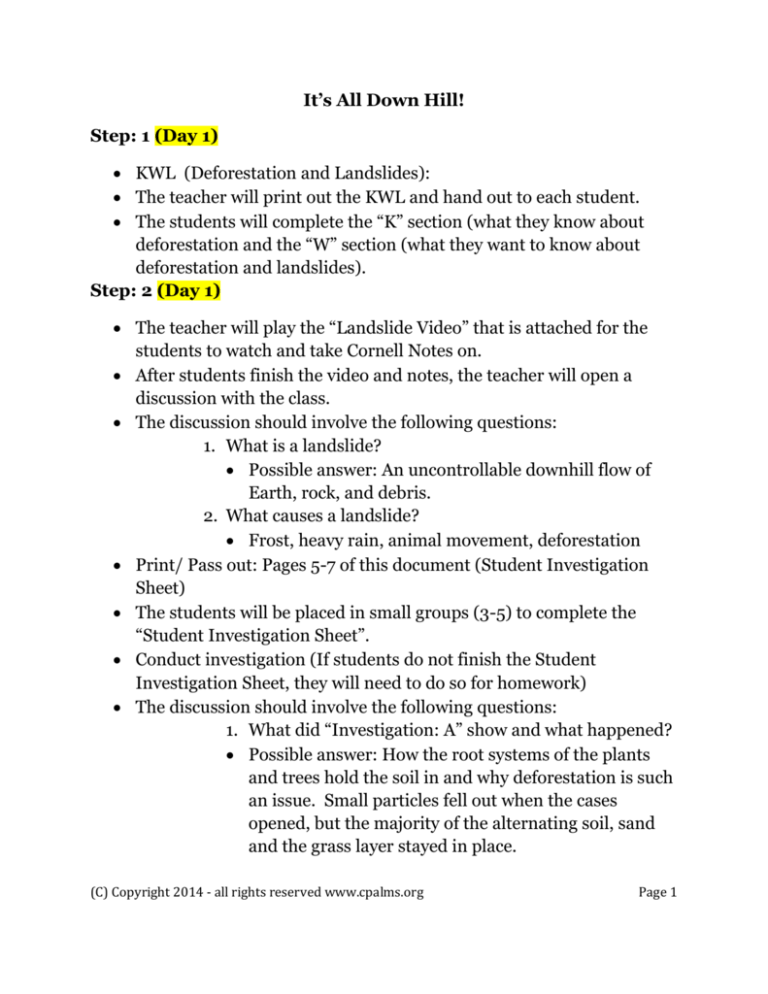
It’s All Down Hill!
Step: 1 (Day 1)
KWL (Deforestation and Landslides):
The teacher will print out the KWL and hand out to each student.
The students will complete the “K” section (what they know about
deforestation and the “W” section (what they want to know about
deforestation and landslides).
Step: 2 (Day 1)
The teacher will play the “Landslide Video” that is attached for the
students to watch and take Cornell Notes on.
After students finish the video and notes, the teacher will open a
discussion with the class.
The discussion should involve the following questions:
1. What is a landslide?
Possible answer: An uncontrollable downhill flow of
Earth, rock, and debris.
2. What causes a landslide?
Frost, heavy rain, animal movement, deforestation
Print/ Pass out: Pages 5-7 of this document (Student Investigation
Sheet)
The students will be placed in small groups (3-5) to complete the
“Student Investigation Sheet”.
Conduct investigation (If students do not finish the Student
Investigation Sheet, they will need to do so for homework)
The discussion should involve the following questions:
1. What did “Investigation: A” show and what happened?
Possible answer: How the root systems of the plants
and trees hold the soil in and why deforestation is such
an issue. Small particles fell out when the cases
opened, but the majority of the alternating soil, sand
and the grass layer stayed in place.
(C) Copyright 2014 - all rights reserved www.cpalms.org
Page 1
2. What did “Investigation: B” show and what happened?
Possible answer: How the soil loses stability when the
root systems are not there to hold alternating layers of
soil and sand in place.
Note: If student was absent on “Day 1”, make sure to pair them with a
student that was present, so they can be brought up to pace.)
Step: 3 (Day 2)
The teacher will show how landslides occur by conducting a
classroom landslide demonstration and promptly conducting a
classroom discussion on the results?
The discussion should involve the following questions:
1) What did the demonstration show?
Possible answer: How the smaller particles (or
sediments travel to the basin first and this
represents a landslide.
2) Was there anything in this demonstration that
surprised you, or that you are confused about?
Possible answer: Answers will vary
Step: 5 (Day 2)
The teacher will pass out the Quiz (Summative assessment) and gage
the level of understanding on the scores achieved.
(C) Copyright 2014 - all rights reserved www.cpalms.org
Page 2
It’s All Downhill!
Teacher Materials / Instructions:
http://www.artprojectsforkids.org/
(Note: Please keep in mind that it will take 3-5 days for the grass seed to
grow. Prepare ahead of time to avoid wasting time in the classroom.)
Materials:
(x2/ each group) ¼ inch thick, clear plastic CD cases
Tap water
Spray bottle
Potting Soil
Sand
Grass seed
Dry erase markers
(x2/ each group) Paper plates
Large rubber bands (to hold the cases together)
(C) Copyright 2014 - all rights reserved www.cpalms.org
Page 3
Teacher Instructions:
Each group will have 2 CD cases. One will look like the above picture and will be
labeled with the letter “A” and will contain: potting soil, sand and germinated
grass seed. This will represent the healthy root systems of trees that hold the soil
in place.
The other CD case will be labeled with the letter “B” and will contain only potting
soil and sand. This will represent an example of human impact.
Plan to have enough materials to account for small groups (3-4 students)
Procedures:
1. Open the “A” CD cases and fill them ½ way (starting at the bottom, so that
when open the case, the lid opens toward you). The layers should be as
follows:
Soil (1/2 inch), sand (1/2 inch), Soil (1/2 inch), sand (1/2 inch), Soil
(1/2 inch) Total soil/ sand height = 2 ½ inches (aprox ½ of the
height of the CD case).
(Rubber band at bottom to hold closed)
2. Repeat the same procedures for the “B” CD cases and set aside.
3. Sprinkle approx. a teaspoon of wet grass seeds on the top layer of soil, so the
roots will grow downward in case “A” only.
(C) Copyright 2014 - all rights reserved www.cpalms.org
Page 4
4. Use a spray bottle of water to spray all of the “A” cases with 7 sprays of tap
water, close the lids and wrap with a large rubber band to keep the lids from
popping open.
5. Place the “A” cases in a bright window and allow 3-5 days to adequate root
growth. Seeds began to germinate within 2 to 3 days, and the grass a few days
after that. The more root growth, the better! The purpose is to see how the
roots provide stability to anchor the layers of soil together.
6. Use a spray bottle of water to spray all of the “B” cases with 7 sprays of tap
water, close the lids and wrap with a large rubber band to keep the lids from
popping open. Place these cases in a box until it is time for the investigation.
Note: The soil stays moist for a long period of time, but it is
important to moisten it as it begins to dry. Use your water bottle
with tap water to spray the “B” case with water to keep the amount
of moisture equal to case “A”(spray both cases with the same
amount of water).
(C) Copyright 2014 - all rights reserved www.cpalms.org
Page 5




